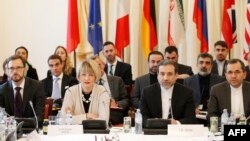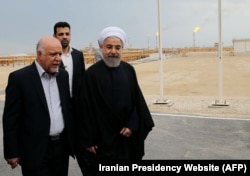The international agreement on Iran's nuclear program moved forward Monday with the first meeting of the Joint Commission responsible for monitoring how both sides implement their parts of the deal, amid some optimism that the plan could roll out by the end of the year.
Key Points of Iran Nuclear Accord
Key Points of the Iran Nuclear Deal
- Iran will reduce stockpile of low-enriched uranium by 98 percent to 300 kg for 15 years
- Iran will reduce by two-thirds the number of centrifuges operating to enrich uranium at its main processing center
- Iran is prevented from designing warheads or conducting experiments on nuclear weapons-related technology.
- Arms embargo on Iran will be eased, as long as IAEA judges Iran's nuclear program to be peaceful.
- International sanctions on Iran will be lifted, enabling it to export oil.
- If an international panel finds Iran is not honoring the accord, it can vote to restore sanctions.
Monday's session brought high ranking officials from Iran and the group that includes the United States, Britain, China, France, Russia, Germany and the European Union back to Vienna, the city where they agreed in July to limit Iran's nuclear program in exchange for needed sanctions relief.
It follows Sunday's so-called Adoption Day when the sides took their first formal steps to implement the deal.
After meeting with senior officials from the multinational team that orchestrated the agreement, Iran's nuclear negotiator Abbas Araqchi said Monday he hopes the next milestone - implementation - will take place by December 31.
The commission is due to meet four times a year and discuss issues such as the design for converting the heavy water research reactor in Arak, projects at the Fordow facility and any issues that arise from implementing the lifting of sanctions. It is also the first stop for either side to report alleged violations of the agreement and try to resolve the issues.
US to lift sanctions
U.S. President Barack Obama said Sunday he had ordered his government to start preparing to lift sanctions against Iran, and that the Iranians had begun work toward their responsibilities to remove thousands of centrifuges, drastically reduce Iran's uranium stockpile and remove the core at the Arak reactor.
"I welcome this important step forward, and we, together with our partners, must now focus on the critical work of fully implementing this comprehensive resolution that addresses our concerns over Iran's nuclear program," Obama said.
The European Union also passed legislation Sunday allowing its members to start looking at ending sanctions.
But German Foreign Minister Frank-Walter Steinmeier predicted the sanctions will remain until Iran proves it is living up to its side of the bargain.
"That definitely won't be the case before the end of January," he said. "Now the question is whether Iran shows that it can fulfill its commitments."
In recent days, Iranian officials have suggested the country could meet its requirements by year’s end.
Potential windfall for Iran
Stratfor analyst Reva Bhalla said if Iran can meet the conditions that lead to sanctions relief, it could economically rehabilitate itself.
“In the immediate sense, it means between 40 and 50 million barrels of oil that Iran has in storage will be released on the market,” she said.
But Ilan Berman, vice president of the American Foreign Policy Council, said as Iranian officials work to get their nuclear sites into compliance, they will need to sell the deal to the country’s hardliners.
“They have to sell their constituency that the Islamic Republic has not changed its stripes, ideologically, despite the deal.”
He also said there is concern about whether Iran will remain in compliance once it begins reaping the benefits of sanctions relief.



